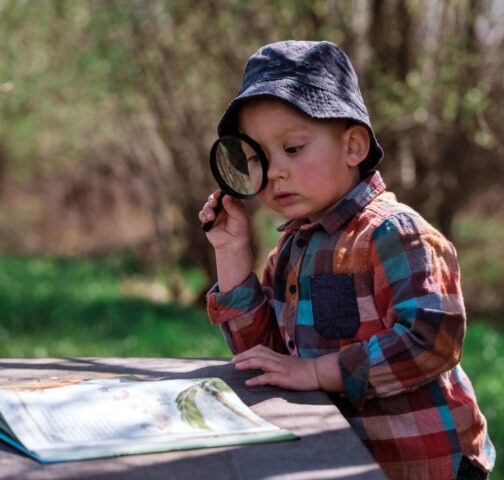You don’t have to go to exotic places to find interesting plants and animals to study at home or in the classroom! Illinois wildlife is as close as your local park or schoolyard. Explore the world of insects with children.
Collect classroom resources.
Ask a librarian to help you find children’s nonfiction books and nature magazines with colorful illustrations. Display insect posters in your classroom. Add laminated pictures of insects to the science center.
Talk about insects.
Ask the children, “What is an insect?” Point out that most adult insects have three body parts and three pairs of legs. Introduce the terms head, thorax, and abdomen. Ask the children about insects they have seen.
Discuss what can be observed about insects, including where they may be found. In gardens? Under rocks or fallen leaves? On trees and shrubs? In the grass or on flowers? Invite a local expert to talk with the children about insects and answer questions. Contact your local community college, Audubon Society, nature center, or gardening club for speakers.
Go on an insect walk.
In the warm months, take a walk with the children to see how many different insects they can find. (Note: Find out first if anyone is allergic to insect stings and bites.) For example, late summer can be a good time to see aphids, milkweed bugs, cicadas, ants, dragonflies, and grasshoppers. Be sure bees, wasps, and hornets are observed only from a distance! Provide each child with paper, pencil, and a clipboard.
Remind the children that they are to observe, not touch. When an insect is found, encourage the children to look for the three body parts and the three pairs of legs. Children can draw and take or dictate notes on the insect and where it was found.
Build insect habitats.
Do the children want to collect insects? If so, make a temporary home by placing dirt, a small stick, and a bottle cap full of water in the bottom of a clear plastic cup. Poke a few small holes in the bottom of a second cup. Using a small butterfly net or another clear cup inverted over a piece of paper, collect an insect, place in the first cup, then tape the inverted second clear cup on top of it. You can also buy kits, such as ant farms.
Observe live insects.
Encourage children to use magnifiers and observe the insects. Ask the children questions: Do the insects have wings? Do they buzz or hum? What colors do you see? Then return the insects to where they were found. Encourage children to observe the life cycles of insects such as mealworms (darkling beetles). Mealworms, which can be bought at a pet store, are easy to raise in a classroom.
IEL Resource
- Resource List: Appreciating the Natural World with Young Children


 PDF
PDF